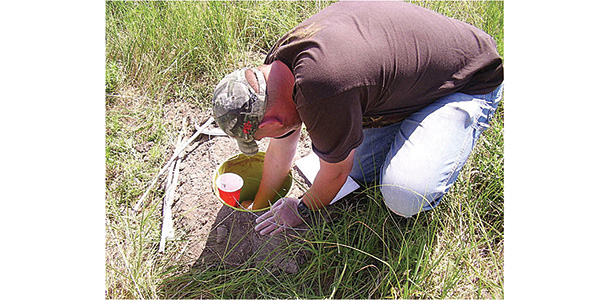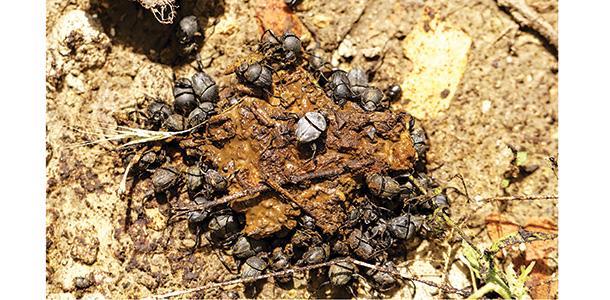There is another “bug” that has a symbiotic relationship that is not as glamorous as forage digestion. Dung beetles feed on manure and use it to house and feed their offspring; in the process, they improve nutrient recycling, soil structure and forage growth.
Easy to overlook as they dine on cow manure across the range, dung beetles play an important role in the pasture ecosystem and deserve attention when considering optimizing stocker operations.
The American Institute of Biological Sciences reports that dung beetles save the U.S. cattle industry an estimated $380 million annually every year through manure recycling.
Habitat and habits
Dung beetles live in many habitats and are found on every continent except for Antarctica. Although there are more than 90 species of dung beetles in the U.S., less than a dozen are significant in dung burial.
Diverse in size and color, dung beetles range from just one-tenth of an inch in length to more than 2 inches and can be metallic in color ranging from black to red.
There are three main behavioral groups that play a role in manure recycling. “Tumbler bugs” or “rollers” work in male-female pairs to roll a ball of dung, called a “brood ball” in dung beetle terminology, away from the manure pile to bury it.
“Tunnelers” bury brood balls near the edge or beneath the manure pile. Both of these behavioral groups are known as “nesters,” since they are preparing a home for their young with their activities.
The third group is the “dwellers” – like the name indicates, they simply use the manure as a home. Diversity of species is important to manure recycling since dung beetles are selective on desired manure “flavor” and will fly up to 10 miles following scent to find their favorite variety.

Dr. Truman Fincher, often referred to as the godfather of the dung beetle movement, highlighted the main ways dung beetles benefit mankind – specifically ranchers.
First, dung beetles increase the degradation of manure, returning areas of pasture that would otherwise be covered to grazing in a shorter period of time.
This process exposes the soil to sunlight and increases the productivity of the land and subsequently the stocking rate.
Research has shown that ruminants prefer not to graze areas close to their own species’ manure, despite the presence of palatable forage. By shortening the time needed for degradation, a greater percentage of the pasture will return to grazing.
Second, dung beetles incorporate manure back into the soil, increasing nitrogen recycling. As much as 80 percent of nitrogen that might have otherwise been lost into the air through volatilization is returned to the pasture and serves to fertilize vegetation growth.
Tunneling behavior of dung beetle also increases the ability of the soil to absorb and hold water, preventing runoff and increasing the available moisture for grass growth. Dung beetle activity enhances soil nutrient cycling, increasing the productivity of soil.
Third, dung beetles cause cow patties to dry out more rapidly, which interrupts the life cycle of parasites that pass from the gastrointestinal tract of the animal through the feces.
By drying out the manure, the life cycle of the parasite is broken and they are unable to proliferate and be ingested by other animals.
On a similar note, dung beetle drying of manure also decreases the suitability as a breeding site for flies. Manure is the breeding ground as well as an incubator for horn flies and face flies, both of which are undesirable for cattle as well as producers.
One cow pie can facilitate the development of as many as 80 horn flies; however, competition for habitat by dung beetles can reduce this number by up to 95 percent. Dung beetles act not only to optimize conditions for cattle grazing but also reduce internal and external parasites.

Matching beetles and manure
Modern pasture management techniques have increased the stocking capacity of much of the pasture land with utilization of high-producing forages and fertilizers.
As a result, many U.S. dung beetles simply cannot keep up. There is more manure deposited than the beetles can break down.
Although there has been some work in importing new varieties of dung beetles to increase the diversity and productivity, there is no clear answer to the dung beetle shortage.
So how do we increase the activity of dung beetles to optimize stocker operations? One common practice that decreases dung beetle proliferation is insecticides used for fly and parasite control.
Although all insecticides reduce the survival of young dung beetles, injectable Ivermectin (and Doramectin) only reduced survival of young species for one to two weeks and Ivermectin pour-on only one to three weeks.
Ivermectin administered as a bolus reduced the survival of young dung beetles for up to 20 weeks. There has also been research that indicates moxidectin pour-on may be the least harmful when it comes to the reproduction cycle of the dung beetle.
Choosing one of the less detrimental forms of insecticide will have less impact on dung beetle population. In addition, treating animals in the cooler months, when dung beetles are dormant, has less of an impact.
Realistically any product used to kill, harm or limit will have some impact on the pasture ecosystem.
Limiting use of these products to the necessity is important in maintaining a healthy ecosystem and dung beetle population.
Fly ear tags and back rubbers are both options that are minimally detrimental to dung beetles. There is significant economic importance to consider with regard to the pasture ecosystem when choosing pest-mitigation strategies.
Another way to help improve dung beetle populations is to implement an intensive rotational grazing system. By using intensive grazing, the amount of manure in a small area can be increased; this allows the dung beetle to spend less time searching for food and more time reproducing and feeding.
By choosing dung beetle-favorable management practices, ranchers can further utilize the benefits these underappreciated members of the ecosystem can offer and optimize pasture conditions. Some easy ways to look for dung beetle activity in your pastures:
- Look for small holes on top of cow pies. These are made by tunnelers.
- Scrape off the top layer of the cow patty and look for beetles scurrying.
- If the manure patties “melt” down in a few days rather than remain for months, dung beetles are likely present.

Kraig Peel is also the director of the Western Center for Integrated Resource Management Systems. Alex Olheiser is a graduate student in beef management systems at Colorado State University.
References omitted due to space but are available upon request. Click here to email an editor.
PHOTOS
PHOTO 1 and 3: Dung beetles help cow patties to dry rapidly and stop the life cycle of parasites.
PHOTO 2: A pitfall trap is a 5-gallon bucket dug into the ground level with the soil. The lid is separated from the bucket by sticks, allowing dung beetles to crawl in, but unable to fly out. Photos courtesy of Sean Whipple.

Assistant Professor
Colorado State University







